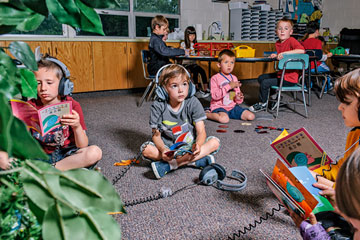
A group of Utah first-graders listen and read along in Mandarin.
(3 of 6)
"They made steady progress through the year," Ridge says. "We started school in August when they could speak only English. They were able to follow directions in Mandarin by January. After that came speaking, then reading, then writing. Now I hear them at recess, mixing Mandarin and English. They help each other out and remind each other of words they forget."
Such cooperation is a formal part of the curriculum in the schools--what the teachers call "pair-share," with kids teaming up and turning to a designated buddy for a lost word or concept. That's a good thing, particularly when it comes to Mandarin, since the Utah school system doesn't fool around. The students are taught to read and write in traditional Mandarin characters, with pinyin--the phonetic, Roman-alphabet form of writing Mandarin--not introduced until the third grade and then only for the more difficult words.
Utah's program got its start in 2009 under then governor and later ambassador to China Jon Huntsman, the rare American political figure who is fluent in Mandarin. Huntsman argued that multilingualism in education would be increasingly essential in the 21st century for students, businesspeople and government officials, and while many people outside the state speculated that the missionary work of the Utah-based Mormon church was the real driver behind the plan, state education officials deny that. "This really was mostly about the state and millennial parents seeing the need for language training," says Roberts.
The program is a surprising bargain by government standards. It's funded by the state legislature at an average of $2 million per year, plus a supplemental appropriation of $10,000 per school per year to buy books. With the program entering its fifth year, that means grades 1 through 4 have already been supplied, with the remaining grades set to be added each year as the oldest kids move along. Both students and teachers are reminded to keep the books in good enough shape that they can be reused each year. "We always tell them, 'Take care of them, because when they're gone, they're gone,'" says Carolyn Schubach, associate director for advanced learning in the Granite school district.
Kids who make it through eighth grade in the language program take advanced-placement courses in ninth. For 10th- through 12th-graders, the state education office is collaborating with the University of Utah and Brigham Young University to offer college-level courses. Whatever Utah is doing, it must be doing it right: so far, officials from 22 other states have dropped by to study the program with an eye toward launching their own.
The Polyglot Brain
